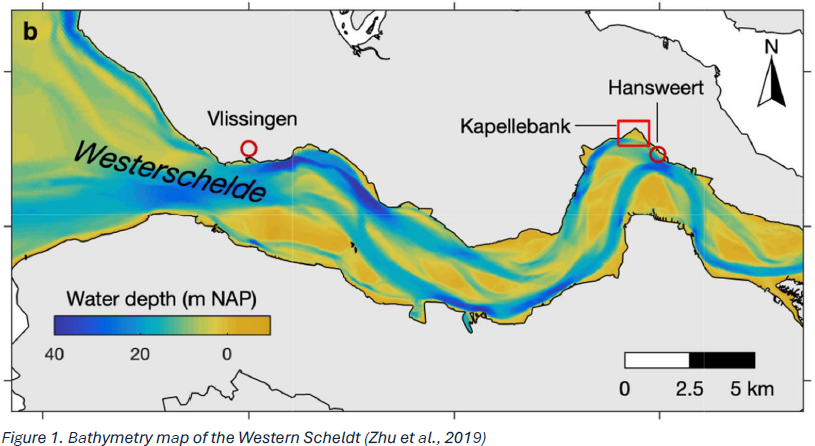The Scheldt estuary’s morphodynamics, particularly that of the Western Scheldt, is extensively studied (e.g. Dam et al., 2016; van der Wegen & Roelvink, 2012). At present, the analyses have been focused on the development of the estuary using only the sediment transport of sand or non-cohesive sediment and its effect on the estuary seabed evolution.
Recently, numerical models have taken into account the effect of the interaction between sand and mud on morphodynamics. Colina Alonso et al. (2023) implemented this interaction in the Delft3D (Deltares, 2023) modeling of an idealized tidal basin. Other models, such as DHI Mike (DHI, 2024) and TELEMAC (TELEMAC.org, 2022), have already implemented this interaction.
This research project will be based at Deltares, in Delft, and involves the long-term (decadal) morphodynamic modeling of the Western Scheldt estuary (Figure 1). The modeling will not only include the natural processes in the estuary but also the effects of human intervention (e.g. dredging and dumping) and sea level rise on the seabed evolution. Finally, the modeling aspect of this research builds on past and current morphodynamic models developed at Deltares and, therefore, will not be starting from scratch.
The expected output of the project is a better understanding of the role of sand-mud interaction in the long-term morphodynamics of the Western Scheldt. This project has four main steps:
- Consolidate data on the relevant hydrodynamic and sediment parameters from past modelingexercises of the Western Scheldt.
- Setup and run Delft3D model of the Western Scheldt with the sand-mud interaction module.
- Validate model results with measured bathymetry of the estuary.
- Scenario testing (e.g. sea level rise) to better understand long-term morphodynamics andunderlying process





